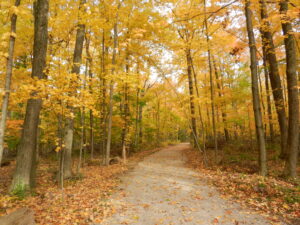By Rich Niccum, Education Services Manager

Many years ago, I was introduced in the early spring to an odd species of bird that I have since grown very fond of. At the time of our introduction, I thought “What a silly little bird! How does it survive?” As I spent more time learning about its natural history, I realized that despite its almost comical appearance, it is a very fascinating and fun bird. And each spring I look forward to its return, not only for its fascinating mating ritual but also as a harbinger of spring. Can you guess what bird I am referring to? Let me give you some more hints starting with its many nicknames. In various parts of the United States, it is known as the Labrador twister, timberdoodle, dood, mudbat, swamp bat, little russet fellars, timber rocket, bogsucker, night partridge, big-eye, bog snipe, and hokumpoke. Colorful names, aren’t they? Each of the nicknames gives a little clue to its looks, actions, etc. I find the nicknames just as fun as the bird itself.
Looking at this bird you would smile and laugh to yourself. With short stubby legs, a plump squat body, with “bug” eyes high on its head, a long narrow bill, and a bobbing walk at times, it is a sight to behold. But wait, it gets better! If the looks of this bird make you chuckle, the mating ritual the males perform in the early spring will bring an even bigger smile to your face. After migrating back to the woodlands of Ohio in March from points south, the males take to the prairies and meadows to perform a fascinating and sometimes comical courtship display, all with the goal of attracting the eye of a female.
At dusk each night, the male flies to a field and begins to make an easily recognized “peent” call, sometimes making this call hundreds of times in an evening. As it makes the call it stomps its feet and even bobs its heads as it turns around in its spot, calling in all directions. If you listen carefully, you can hear the direction and volume of the call change as the bird does its dance. After a period of time ranging from a minute or two to several minutes, the male takes to the air with a twittering sound emanating from its wings as he flies. The male begins its aerial courtship in an upside-down vortex, beginning with a large circumference and gradually getting smaller as it flies higher, sometimes hundreds of feet in the air. As he flies you will hear warbling flutelike calls that get faster as he gets higher and higher, and then as suddenly as he started, the sounds stops and he drops back down to the ground, many times in the exact spot where he originated his display. And in this spot, he begins the whole process over again, and again, until he becomes invisible to the naked eye. The male will mate with as many females as he can throughout March and into early April and then disappears into the woods to live off of worms, larvae, and other insects until is time to fly south for the winter.
Can you see why I have grown fond of this bird over the years? What a goofy but fascinating bird! I love sharing the mating ritual and the natural history of this bird with anyone who will venture out with me in the spring. Last week, I shared the fascinating life of the American woodcock (Scolopax minor) as it is scientifically known, with a lovely couple who braved the bitter cold and driving snow to see their first woodcock as several flew over our heads at close range, providing us an excellent glimpse of these silly birds. By the end of the short viewing period that night we saw at least six timberdoodles, with even more calling.
Have I piqued your interest? If so, I will be sharing my love of these birds one more time, on Friday, March 18 at 7:30 p.m. at Hickory Woods Park, off of Pollock Road. It looks like the weather forecast is calling for more pleasant temperatures, but with the possibility of rain, which shouldn’t dampen the spirts of the woodcock too much. If you can’t join me, don’t worry you can hear and even see woodcock in many of the prairie areas of the parks, sometimes you don’t even have to leave your car. The parks are open until 9 p.m. so you have plenty of time to enjoy the sights and sounds of the bogsucker at dusk this spring. Have fun!






